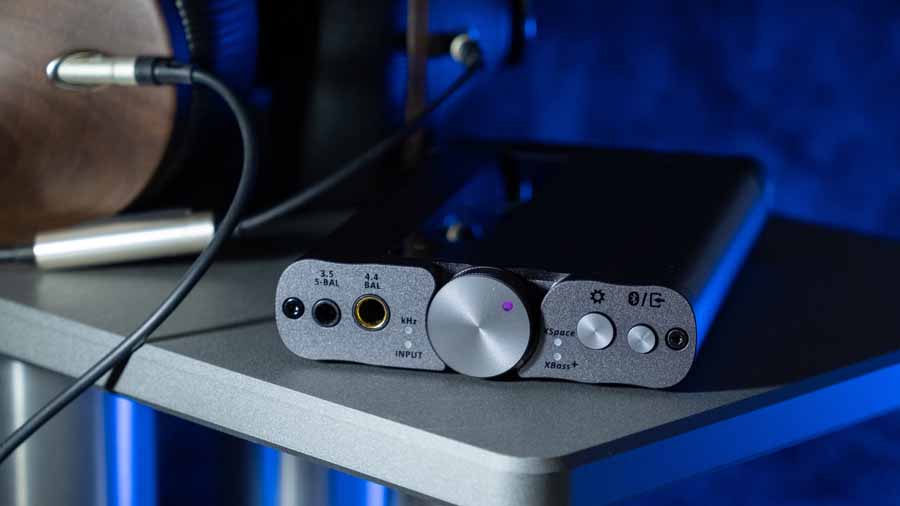 IFI XDSD GRYPHON DAC/HEADPHONE AMPLIFIER LAUNCHED
IFI XDSD GRYPHON DAC/HEADPHONE AMPLIFIER LAUNCHED
Launched in 2018, the xDSD is among the most popular portable DAC/headphone amps in iFi’s range, now they are launching the iFi xDSD Gryphon.
IFI X SERIES
Soon after its launch, the iFi xDSD was joined by the iFi xCAN to complete iFi’s mid-level ‘x-series’ of portable devices. Housed in the same distinctive contoured case with a ‘dark titanium’ finish, the xDSD and xCAN perform differing functions, the former is a portable DAC/headphone amp for digital sources, with USB, S/PDIF and Bluetooth connectivity; the latter is a headphone amp with purely analogue inputs, plus the added convenience of Bluetooth reception for smartphones and so on. The xCAN also includes a balanced output stage.
This autumn, iFi launches its next-generation x-series device, the iFi xDSD Gryphon, iFi’s most ambitious portable DAC/amp yet. It replaces not only the xDSD but also the xCAN, combining the functionality of both with redesigned circuitry.
IFI XDSD GRYPHON
Retaining the contoured design of its antecedents, the iFi xDSD Gryphon is clearly an x-series device. Although a little larger, measuring 123x75x19mm, it remains sufficiently compact to stow away in a small bag. At 215g, it is not an overly hefty device thanks to its lightweight yet robust alloy enclosure, and its gunmetal grey finish is less prone to fingerprints than the glossy dark titanium of the original xDSD and xCAN. The extra space provided by the xDSD Gryphon’s larger chassis is fully utilised by the entirely re-engineered tech within, harnessing iFi’s latest technical developments.
WIDE CONNECTIVITY OPTIONS
Key to the xDSD Gryphon’s flexibility is the range of equipment to which it can be connected. Digital and analogue cable inputs are provided – the former in USB and S/PDIF flavours, and the latter via balanced 4.4mm Pentaconn and single-ended 3.5mm sockets. High-definition Bluetooth reception is also provided, enabling smartphones, tablets and more to connect wirelessly.
At the rear, two USB–C ports are provided – one input for digital audio, handled asynchronously, and the other for charging, thus keeping the audio and power lines separate for reasons both practical and sonic. Next to these lies the S/PDIF digital input, which allows both optical and electrical (3.5mm) connections.
3.5mm and 4.4mm Pentaconn analogue sockets are also supplied at the back, for single-ended and balanced connections respectively. These double as both inputs and outputs – inputs when the xDSD Gryphon is being used as an analogue headphone amp; outputs to enable its use as a DAC/preamp in a home audio system, with fixed and variable options to connect to an amp and speakers.
At the front, a pair of headphone outputs are provided – a 3.5mm socket for headphones with a single ended cable/connector, and a 4.4mm Pentaconn output enabling headphones equipped with balanced connectivity to take full advantage of the xDSD Gryphon’s balanced amp design. The 3.5mm output benefits from iFi’s S-Balanced circuitry, cutting crosstalk and related distortion in half when used with regular, single-ended headphone connections.
Built into the top surface is an OLED display strip, showing a range of useful information including input selection, volume level, battery level, digital audio format and sample rate, along with various other settings. This combines with controls and front-panel LED lighting to ensure the xDSD Gryphon is enjoyable to use.
IFI XDSD GRYPHON DIGITAL ENGINE
The xDSD Gryphon’s ‘digital engine’ is based around a Burr-Brown DAC chipset that iFi uses extensively, selected for its ‘musicality’ and True Native architecture. The xDSD Gryphon uses a low-latency, 16-core XMOS microcontroller delivering enhanced processing power; iFi’s in-house digital development team has programmed the XMOS firmware to optimise sound quality and ensure a perfect partnership with the Burr-Brown DAC.
Extensive jitter-eradication technologies are also applied to the digital stage, including the latest generation of iFi’s GMT (Global Master Timing) femto-precision clock and intelligent memory buffer.
HI RES MUSIC
Hi-res audio support handles PCM data to 32-bit/768kHz, all levels of DSD to DSD512, and single- and double-speed DXD. Thanks to the Burr-Brown DAC chip’s four-channel True Native design, PCM and DSD take separate pathways – this enables DSD, as well as PCM, to remain bit-perfect in its native form right through to analogue conversion.
MQA – the hi-res streaming codec, as used by Tidal’s ‘Masters’ tier – is also supported through the USB and S/PDIF inputs, with full decoding of MQA files up to 384kHz. This means that the full ‘three unfold’ decoding process is performed internally, as opposed to only the final unfold in the manner of an MQA ‘renderer’.
BLUETOOTH
While Bluetooth’s convenience and wide device compatibility are well recognised, many people don’t realise how good Bluetooth audio can sound because they’ve only experienced it at base-level quality via rudimentary SoC (System on Chip) implementations. Making full use of Qualcomm’s latest four-core QCC5100 Bluetooth processing chip, every current high-definition Bluetooth audio format is supported, including aptX Adaptive and aptX HD, LDAC and HWA/LHDC. Other codecs covered include regular aptX and aptX Low Latency, AAC and SBC (the ‘plain vanilla’ Bluetooth codec).
The xDSD Gryphon is Bluetooth v5.1-compliant, ensuring the best possible range, stability and performance. Up to seven paired Bluetooth source devices can be stored in memory, making it easy to switch from one device to another.
IFI XDSD GRYPHON BALANCED ANALOGUE STAGE
iFi has gradually introduced fully balanced circuit design across its range, first in the flagship Pro Series components, then in the entry-level ZEN Series devices, with varying levels of sophistication. PureWave is the name iFi has given to the advanced, symmetrical dual-mono circuit topologies found in its latest premium-level devices, such as the NEO and Diablo DAC/amps. The iFi xDSD Gryphon is the smallest and most affordable device to feature PureWave design.
High-quality components are used throughout, including custom ultra-low-distortion op-amps, multilayer ceramic TDK C0G capacitors, MELF thin-film resistors and inductors from Murata and Taiyo Yuden. These are more costly than common equivalents, but class-leading qualities such as low ESR (Equivalent Series Resistance), high linearity and low noise pay dividends in terms of sound quality.
The headphone amp stage has a continuous power output of more than 1000mW into a 32-ohm load available through the balanced headphone socket.
OPTIMALOOP
‘Negative feedback’ is often used in amplifier circuits to compare the output signal with the input signal and correct errors, in order to control gain and reduce distortion.
Recognising that different parts of a circuit benefit from specifically optimised feedback loops, iFi has developed a negative feedback system that incorporates multiple feedback paths instead of one global loop, each path optimised for a particular function and working synergistically with the others to deliver optimal overall performance. iFi calls this new configuration OptimaLoop.
IFI CYBERSYNC VOLUME CONTROL
iFi has long championed high-quality analogue volume controls over digital volume adjustment, from a sound quality perspective. The xDSD Gryphon features a new iFi innovation called CyberSync, a redesign of the CyberDrive volume control featured in the original xDSD. CyberSync is a software-driven volume control that operates in the analogue domain. iFi’s CyberSync volume control provides volume synchronisation between the source and the DAC. It detects which operating system (OS) the DAC is connected to – iOS, Android, Windows, Mac OS or Linux – and instructs the source’s OS to bypass its software volume control. Whether the volume is adjusted using the xDSD Gryphon’s rotary control or on the source device, CyberSync ensures the change is performed purely by Gryphon’s analogue control chip, while also displaying the adjustment on the source device’s screen.
IFI XDSD GRYPHON NOISE REDUCTION
Every element of the iFi xDSD Gryphon’s electronic design has been considered to prevent distortion and raise the signal-to-noise ratio. Its low-noise, high-bandwidth power supply circuitry sports linear regulation and delivers excellent PSRR (Power Supply Rejection Ratio) performance. The dimmable OLED display’s SilentLine design ensures there is no electrical noise to interfere with the audio signal.
IFI XBASS II
iFi’s sonic tailoring options ensure the user can calibrate the iFi xDSD Gryphon’s sound to suit their specific preferences. With digital sources, users can choose between three bespoke digital filters via the on-screen menu: Bit-Perfect, Standard and GTO (Gibbs Transient Optimised), each having a fine-tuning effect on sound.
Further sonic tuning is provided by iFi’s proprietary analogue processing. Familiar to users of other iFi DAC/amps is XBass – a form of ‘bass boost’ that enhances low frequencies without muddying the midrange, useful with earphones and open-back headphones that may lack deep bass. Like the xCAN before it, the xDSD Gryphon sports an expanded version called XBass II, offering three separate headphone EQ options: ‘Bass’ (which targets low frequencies), ‘Presence’ (which focuses on the upper midrange) and ‘Bass + Presence’ (which implements both together).
XSpace is another user-selectable mode, designed to compensate for the ‘in-head localisation’ effect that can occur when using headphones to listen to music that was mixed using a pair of speakers, effectively widening the headphone soundstage to deliver a more spacious and speaker-like experience. Both XBass II and XSpace operate entirely in the analogue domain and may be switched in or out of the signal path. A further switch on the base of the xDSD Gryphon engages IEMatch, another proprietary iFi circuit that attenuates the headphone output to better suit high-sensitivity headphones and in-ear monitors, removing potential background noise and increasing the usable volume range.
IFI XDSD GRYPHON PRICE AND AVAILABILITY
Available from mid-November at an RRP of £599.





























































































































































































































